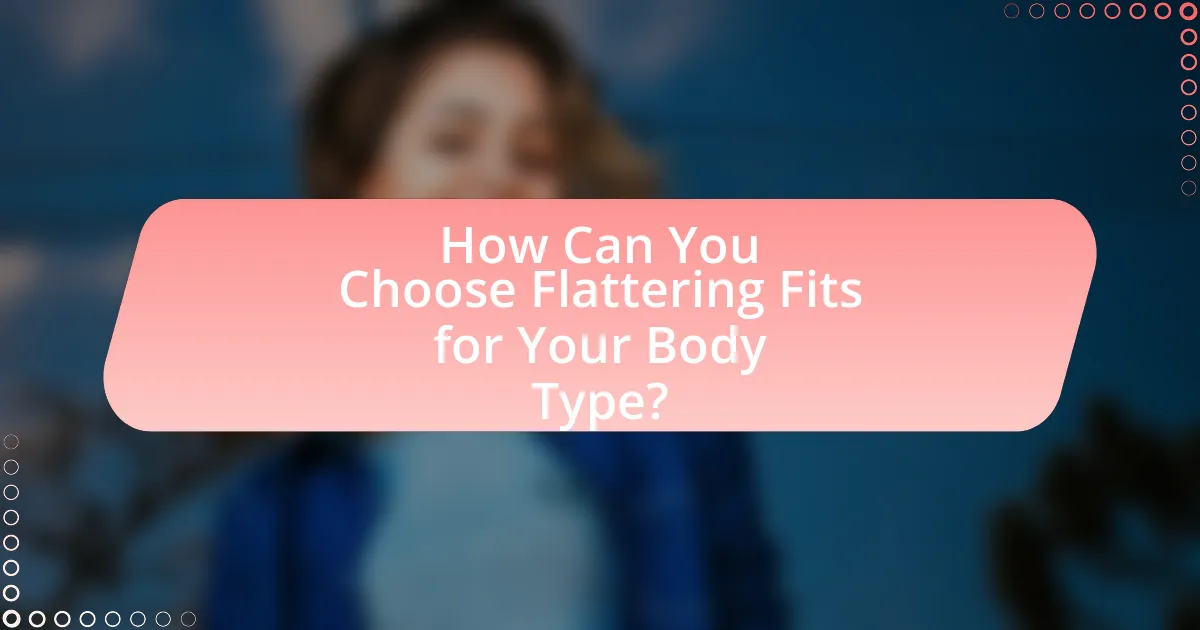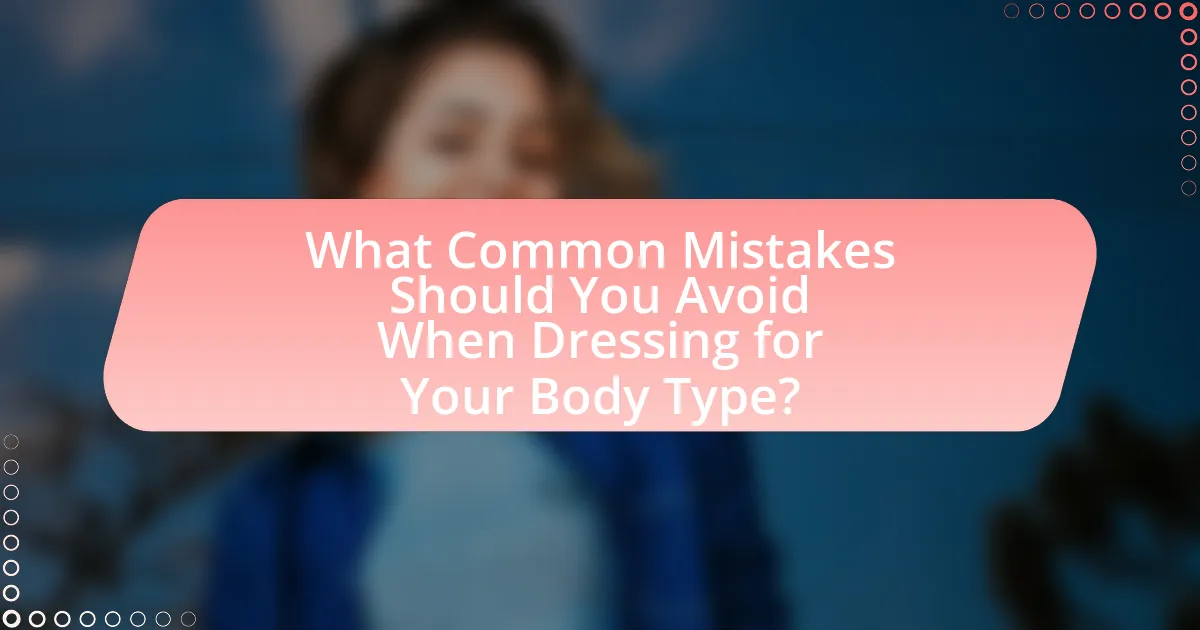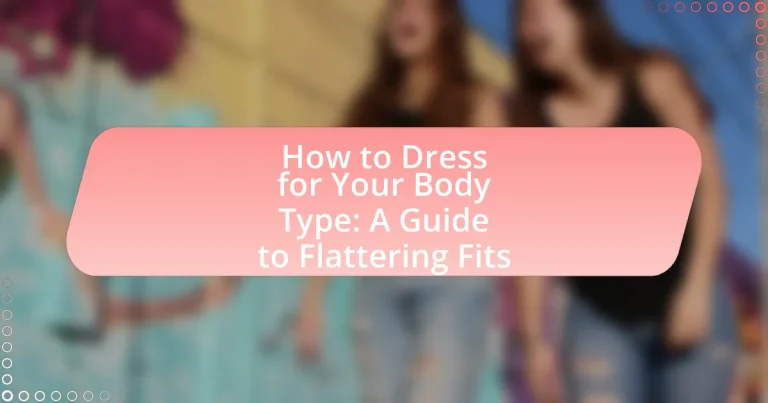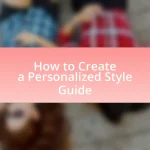The article “How to Dress for Your Body Type: A Guide to Flattering Fits” provides a comprehensive overview of dressing strategies tailored to various body types, including hourglass, pear, apple, and rectangle shapes. It emphasizes the importance of selecting clothing that enhances natural proportions and boosts confidence, supported by research linking well-fitted attire to improved self-esteem. The article outlines practical tips for identifying body types, choosing flattering styles, and accessorizing effectively, while also addressing common dressing mistakes to avoid. Additionally, it offers guidance on transitioning wardrobes for different occasions and building a versatile collection based on individual body shapes.

What Does It Mean to Dress for Your Body Type?
Dressing for your body type means selecting clothing that enhances your natural shape and proportions, creating a balanced and flattering appearance. This approach involves understanding your specific body type—such as hourglass, pear, apple, or rectangle—and choosing styles, cuts, and fabrics that complement your features. For instance, individuals with an hourglass figure may benefit from fitted clothing that accentuates the waist, while those with a pear shape might opt for A-line skirts that draw attention away from the hips. By dressing according to body type, individuals can improve their overall look and boost confidence, as supported by fashion experts who emphasize the importance of fit and proportion in personal style.
Why is Dressing for Your Body Type Important?
Dressing for your body type is important because it enhances your overall appearance and boosts confidence. When individuals choose clothing that complements their specific body shape, they can highlight their best features and create a balanced silhouette. Research indicates that wearing well-fitted clothing can positively affect self-esteem and body image, as noted in a study published in the Journal of Fashion Marketing and Management, which found that individuals who dress according to their body type report higher satisfaction with their appearance.
How can the right clothing enhance your confidence?
The right clothing can enhance your confidence by improving your self-image and making you feel more comfortable in social situations. When individuals wear clothes that fit well and complement their body type, they often experience a boost in self-esteem, as supported by a study published in the Journal of Experimental Social Psychology, which found that participants who dressed in a way that aligned with their self-perception reported higher levels of confidence. This alignment between clothing and body type not only influences how individuals perceive themselves but also affects how others perceive them, reinforcing a positive feedback loop that further enhances confidence.
What impact does body type have on clothing choices?
Body type significantly influences clothing choices by determining which styles, cuts, and fits enhance an individual’s appearance. For instance, individuals with an hourglass figure often benefit from fitted clothing that accentuates their waist, while those with a rectangular body type may prefer styles that create curves, such as peplum tops. Research indicates that understanding body type can lead to improved self-esteem and body image, as individuals are more likely to select outfits that flatter their unique shapes. This correlation between body type and clothing choices is supported by studies in fashion psychology, which highlight the importance of fit and style in personal expression and confidence.
What Are the Different Body Types?
The different body types are typically categorized into three main classifications: ectomorph, mesomorph, and endomorph. Ectomorphs are characterized by a slim, lean physique with narrow shoulders and hips, often having difficulty gaining weight. Mesomorphs possess a muscular build with broader shoulders and a narrower waist, making it easier for them to gain and lose weight. Endomorphs have a rounder body shape with wider hips and a tendency to store fat, making weight loss more challenging. These classifications are based on the somatotype theory developed by William Sheldon in the 1940s, which has been widely referenced in fitness and fashion contexts to help individuals understand their body shapes for better dressing choices.
How can you identify your body type?
To identify your body type, assess your body shape by measuring key areas: shoulders, waist, and hips. The three primary body types are ectomorph (slender with narrow shoulders and hips), mesomorph (muscular with broad shoulders and a defined waist), and endomorph (rounder with wider hips and a softer physique). Accurate measurements can be taken using a measuring tape, and comparing these dimensions helps categorize your body type effectively. This method is supported by fitness and nutrition experts who emphasize the importance of understanding body composition for tailored clothing choices.
What are the characteristics of each body type?
There are three primary body types: ectomorph, mesomorph, and endomorph. Ectomorphs are characterized by a slim, lean build with narrow shoulders and hips, often having difficulty gaining weight. Mesomorphs possess a muscular and athletic physique, with broad shoulders and a naturally higher muscle mass, making it easier for them to gain or lose weight. Endomorphs have a rounder, softer body shape with wider hips and a tendency to store fat, making weight loss more challenging. These classifications are based on somatotype theory developed by William Sheldon in the 1940s, which categorizes individuals based on their physical characteristics and body composition.

How Can You Choose Flattering Fits for Your Body Type?
To choose flattering fits for your body type, first identify your specific body shape, such as hourglass, pear, apple, or rectangle. Each shape has distinct characteristics that dictate which styles enhance your natural silhouette. For example, hourglass figures benefit from fitted clothing that accentuates the waist, while pear shapes look great in A-line skirts that balance wider hips. Research indicates that wearing clothes that align with your body shape can improve self-esteem and body image, as supported by a study published in the Journal of Fashion Marketing and Management, which found that individuals who dress according to their body type report higher satisfaction with their appearance.
What Styles Work Best for Each Body Type?
Different styles work best for various body types, enhancing natural shapes and proportions. For an hourglass figure, fitted clothing that accentuates the waist, such as wrap dresses and high-waisted skirts, is ideal. For pear-shaped bodies, A-line skirts and structured tops help balance proportions by drawing attention to the upper body. In contrast, apple-shaped figures benefit from styles that create a defined waist, like empire waist dresses and tailored blazers. Athletic body types can opt for styles that add curves, such as peplum tops and ruffled details. Lastly, for rectangular body types, layering and belting can create the illusion of curves. These recommendations are supported by fashion experts who emphasize the importance of fit and proportion in achieving a flattering look.
How do you dress an hourglass figure?
To dress an hourglass figure, choose clothing that accentuates the waist and highlights curves. Fitted dresses, high-waisted skirts, and tailored tops create a balanced silhouette. Additionally, wrap dresses and belted styles emphasize the waist, while V-necklines elongate the torso. Research indicates that hourglass figures benefit from structured garments that define the waist, as this enhances their natural proportions.
What are the best clothing options for a pear-shaped body?
The best clothing options for a pear-shaped body include A-line dresses, high-waisted skirts, and tops with embellishments or structured shoulders. A-line dresses accentuate the waist while providing a flattering silhouette that skims over the hips. High-waisted skirts help define the waist and balance the proportions of the body. Tops with embellishments or structured shoulders draw attention upward, creating a more balanced look. These choices are supported by fashion experts who recommend styles that enhance the upper body while providing comfort and style for the lower body.
How Can You Accessorize to Complement Your Body Type?
To accessorize effectively for your body type, choose pieces that enhance your natural proportions. For example, if you have an hourglass figure, opt for belts to accentuate your waist and statement earrings to draw attention upward. Conversely, if you have a rectangular body shape, layered necklaces can create the illusion of curves, while bold bracelets can add interest to your arms. Research indicates that accessories can significantly influence perceived body proportions, as highlighted in a study by the Journal of Fashion Marketing and Management, which found that strategic accessorizing can enhance overall body aesthetics.
What types of accessories enhance different body shapes?
Accessories can enhance different body shapes by complementing proportions and creating balance. For example, individuals with an hourglass shape benefit from belts that accentuate the waist, while those with a pear shape can use statement necklaces to draw attention upward. Rectangular body shapes may find that layered necklaces add dimension, and apple shapes can opt for long, flowing scarves to create vertical lines. These accessory choices are supported by fashion principles that emphasize the importance of proportion and balance in styling.
How can you use accessories to create balance?
Accessories can be used to create balance by strategically adding elements that complement or counteract body proportions. For instance, if someone has a larger upper body, wearing a statement necklace can draw attention upward, while a flowing scarf can soften the silhouette. Conversely, for those with wider hips, a structured belt can define the waist and create a more balanced look. Research indicates that visual balance in fashion can enhance overall appearance and confidence, as seen in studies on body image and style choices.

What Common Mistakes Should You Avoid When Dressing for Your Body Type?
When dressing for your body type, avoid wearing ill-fitting clothes, as they can detract from your overall appearance. Ill-fitting garments, whether too tight or too loose, can create unflattering silhouettes and draw attention to areas you may want to minimize. Additionally, neglecting to consider proportions can lead to outfits that do not enhance your shape; for example, pairing a voluminous top with equally voluminous bottoms can overwhelm your figure. Another common mistake is ignoring the importance of color and fabric choice; certain colors and materials can either highlight or conceal body features. Lastly, failing to accessorize appropriately can result in a lack of cohesion in your outfit, making it appear incomplete.
What Are the Most Common Dressing Mistakes?
The most common dressing mistakes include wearing ill-fitting clothes, neglecting body shape, and choosing the wrong colors. Ill-fitting clothes, such as overly tight or baggy garments, can create an unflattering silhouette and detract from overall appearance. Neglecting body shape leads individuals to select styles that do not enhance their natural features; for example, a pear-shaped body may benefit from A-line dresses that accentuate the waist. Choosing the wrong colors can wash out skin tones or clash with personal style, making it essential to select hues that complement one’s complexion. These mistakes are frequently observed in fashion choices and can significantly impact how individuals are perceived.
How can ill-fitting clothes affect your appearance?
Ill-fitting clothes can significantly detract from your appearance by creating an unflattering silhouette. When clothing is too tight, it can emphasize unwanted areas, such as bulges or discomfort, leading to a less polished look. Conversely, overly loose garments can appear sloppy and fail to define the body’s shape, resulting in a lack of structure. Studies indicate that well-fitted clothing enhances confidence and perceived attractiveness, as individuals are often judged based on their attire. Therefore, the fit of clothing plays a crucial role in how one is perceived in social and professional settings.
Why is it important to avoid trends that don’t suit your body type?
Avoiding trends that don’t suit your body type is crucial for enhancing personal appearance and confidence. When individuals wear styles that align with their body shape, they are more likely to highlight their best features and create a balanced silhouette. Research indicates that clothing that fits well can significantly impact self-esteem and body image, as noted in a study published in the Journal of Fashion Marketing and Management, which found that individuals who dress according to their body type report higher satisfaction with their appearance. Therefore, selecting appropriate trends not only improves physical presentation but also fosters a positive self-perception.
How Can You Transition Your Wardrobe for Different Occasions?
To transition your wardrobe for different occasions, categorize your clothing into formal, casual, and semi-formal pieces. This allows for easy selection based on the event type. For example, formal occasions require tailored suits or elegant dresses, while casual outings can be suited with jeans and t-shirts. According to a study by the Fashion Institute of Technology, having a versatile wardrobe with interchangeable pieces enhances outfit options and reduces decision fatigue. By maintaining a balance of essential items in each category, you can efficiently adapt your style to various settings.
What should you consider when dressing for formal events?
When dressing for formal events, you should consider the fit, fabric, and appropriateness of the attire for the occasion. A well-fitted outfit enhances your body type, ensuring comfort and confidence. Fabrics such as silk, wool, or high-quality blends are typically preferred for their elegance and drape. Additionally, understanding the event’s dress code—whether black tie, cocktail, or business formal—guides your choice, ensuring you align with social expectations. For instance, a study by the Journal of Fashion Marketing and Management highlights that appropriate attire positively influences perceptions of professionalism and competence.
How can you adapt casual outfits to flatter your body type?
To adapt casual outfits to flatter your body type, choose clothing that enhances your natural shape and balances proportions. For example, if you have an hourglass figure, opt for fitted tops that accentuate the waist and pair them with high-waisted jeans to highlight curves. If you have a pear shape, consider A-line skirts and structured tops to draw attention to your upper body while providing a balanced silhouette. For an athletic build, layering with soft fabrics can create curves, while adding accessories like belts can define the waist. Research indicates that understanding body proportions can significantly improve outfit choices, leading to increased confidence and satisfaction in personal style.
What Practical Tips Can Help You Dress for Your Body Type?
To dress for your body type effectively, focus on understanding your specific shape and selecting clothing that enhances your best features. For example, individuals with an hourglass figure should emphasize their waist with fitted clothing, while those with a pear shape can balance their proportions by wearing A-line skirts and structured tops. Research indicates that dressing according to body type can improve self-esteem and body image, as noted in a study published in the Journal of Fashion Marketing and Management, which found that individuals who dress to flatter their body shape report higher satisfaction with their appearance.
How can you build a versatile wardrobe based on your body type?
To build a versatile wardrobe based on your body type, first identify your specific body shape, such as hourglass, pear, apple, or rectangle. Each body type has distinct characteristics that influence the most flattering clothing choices. For example, hourglass figures benefit from fitted clothing that accentuates the waist, while pear shapes should focus on balancing proportions with A-line skirts and structured tops.
Research indicates that understanding body proportions can enhance personal style and confidence, as noted in studies by fashion experts like Trinny Woodall and Susannah Constantine, who emphasize the importance of fit and silhouette in their book “What Not to Wear.” By selecting pieces that complement your shape, such as tailored blazers for rectangles or wrap dresses for hourglass figures, you create a cohesive wardrobe that allows for versatility in styling.
What are some quick styling tips for everyday outfits?
To enhance everyday outfits, focus on fit, layering, and accessorizing. Proper fit is crucial; clothing should neither be too tight nor too loose, as it can significantly affect appearance. Layering adds dimension; for instance, pairing a fitted top with a loose cardigan creates balance. Accessories like belts can define the waist, while statement jewelry can elevate a simple outfit. These techniques are widely recognized in fashion, as they help create a polished look suitable for various occasions.


